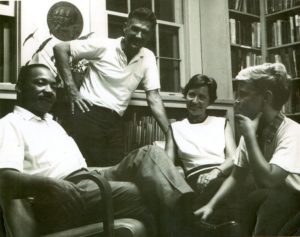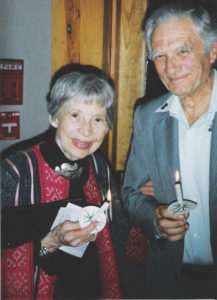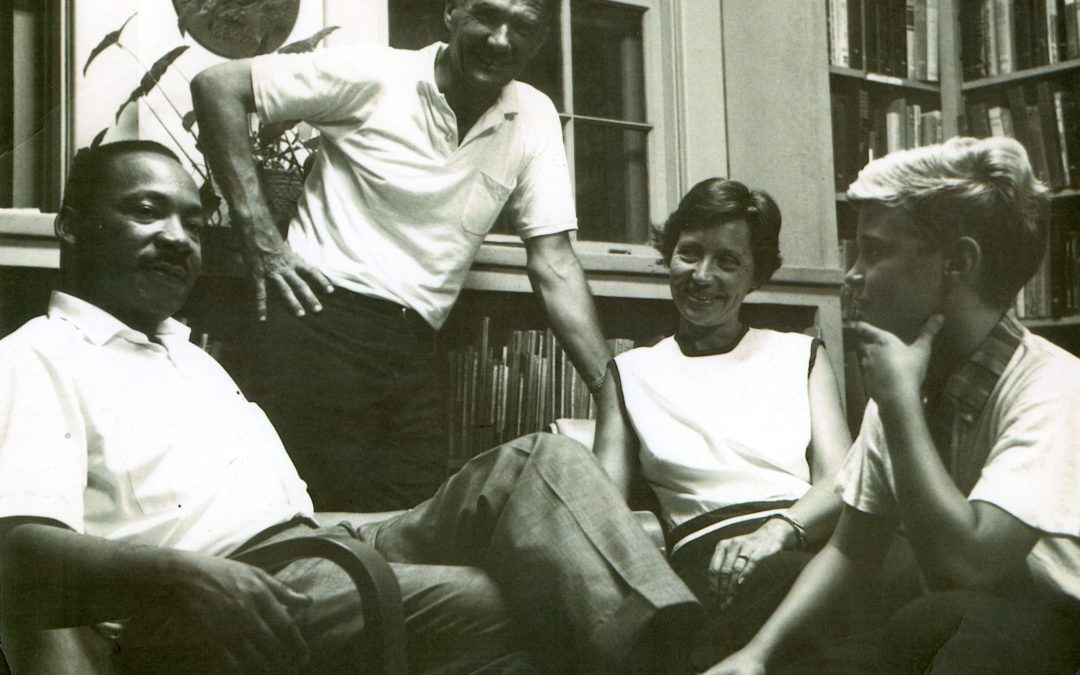Courtney and Elizabeth Siceloff met in Sweden on a Quaker sponsored tour of Scandinavian cooperatives in 1949 and then continued to live their lives together in service. Their first service began in 1950 at the newly formed Penn Center on St. Helena Island in South Carolina, with Courtney becoming the first director. The Penn Center was preceded by the Penn School formed after the Civil War to educate the children of newly freed slaves.

Elizabeth and Courtney Siceloff meet with Martin Luther King Jr. at Friends House which is now Atlanta Friends Meeting in the early 60’s.
Courtney was to serve in this role for nearly 20 years and under his leadership, Penn Center became a force for integration and social change in South Carolina and in the Southeast. Althea Sumpter, who grew up on St. Helena described Courtney and Elizabeth as “creating a safe-haven where civil rights and human rights thinkers who believed in the goodness of humanity gathered and nurtured movements. I thought much of how movements unfolded came out of how Courtney and Elizabeth gave selflessly and lived their lives. I call Elizabeth and Courtney mom and dad, because their simple living spoke to me through childhood on St. Helena Island in the 1950’s and 60’s until I found my own spirit in Atlanta Friends Meeting. They will always be known as members of the St. Helena Island community.” It was one of the few places where African Americans and white people could meet together so civil rights organizations and notable leaders, including Dr. Martin Luther King met there frequently.
Courtney traveled extensively around the Southeast as a regional consultant to the U.S. Commission on Civil Rights and also served on the South Carolina Advisory Committee to the U.S. Commission. Discrimination cases were brought before this Advisory Committee related to poverty, education, school integration, housing discrimination, urban renewal, employment practices, the voting Rights of 1965 and discrimination in hospital and health facilities. Courtney also traveled nationally to raise money for the organization and brought in the Peace Corps and American Friends Service Committee to help keep Penn Center viable. Elizabeth had an important supportive role at Penn Center. One person at her memorial service in 2003 recalled her hosting many people, organizing events and being a supportive, assisting presence for Courtney as he traveled extensively in the region and in the country.
After nearly 20 years there the  Siceloffs decided that it was time to turn the center’s leadership over to African Americans. This happened in the context of a national re-examination of the leadership roles for white people in the civil rights movement. When their service at Penn Center ended in 1969, the Siceloffs left in to work 4 years in the Peace Corps in Afghanistan. Courtney was a program development officer and Elizabeth assisted the U.S. Information Agency by helping Afghans to come to the U.S. for study. Her daughter Mary remembers her spending time teaching English as a second language to people where they lived. Her son John remembers that “she traveled widely during this period including a trek through Nepal and a train ride through Siberia.” Their children, who shared in many of these travels and experiences, benefited from their life of service and Courtney and Elizabeth were able to look with great joy and satisfaction for the adults their children became.
Siceloffs decided that it was time to turn the center’s leadership over to African Americans. This happened in the context of a national re-examination of the leadership roles for white people in the civil rights movement. When their service at Penn Center ended in 1969, the Siceloffs left in to work 4 years in the Peace Corps in Afghanistan. Courtney was a program development officer and Elizabeth assisted the U.S. Information Agency by helping Afghans to come to the U.S. for study. Her daughter Mary remembers her spending time teaching English as a second language to people where they lived. Her son John remembers that “she traveled widely during this period including a trek through Nepal and a train ride through Siberia.” Their children, who shared in many of these travels and experiences, benefited from their life of service and Courtney and Elizabeth were able to look with great joy and satisfaction for the adults their children became.
At Elizabeth’s memorial service in 2003, Tamor Shah, an Afghan American who knew the Siceloffs for 20 years remembered that the Siceloffs came to Afghanistan with an open mind and heart. He said that they lived with the Afghans and graciously shared their skills with students and people in their communities. In 1973 Courtney and Elizabeth returned with their family from Afghanistan to live in Atlanta. Both were active in the Atlanta Friends Meeting and in their neighborhood. Courtney worked with the US Commission on Civil Rights from 1973 until 1982. He resigned in frustration as the Commission in his view became ineffective under the Reagan Administration. Elizabeth began working with the Southern Regional Council, an organization dedicated to equal opportunity with media relations. She also worked for the local bureaus of the Los Angeles Times, US News and World Report and Reuters, helping track regional stories. Their home was a regular meeting place for neighbors and friends to gather to meet guests from around the world. They completed their lives as they began together – in service to their community, their nation and the world.
Courtney passed away in January of 2014.


I understand the in the 1960’s when Atlanta’s high schools were going to be integrated that the Quakers help prepare the black students to be nonviolence.
Can anyone give me more information about that. I live in East Atlanta near one of the schools, Crim, it was called Murphy HS then.
Hi Stephanie, great question! The only thought I would have about where to find more information would be to check out Atlanta Friends Meeting’s library, and in particular a book called “As Way Opened: A History of Atlanta Friends1943-1997.” This book has some information/shares about the meeting’s work in integrating schools. You can find more about this community here: http://quaker.org/legacy/atlanta/about.htm